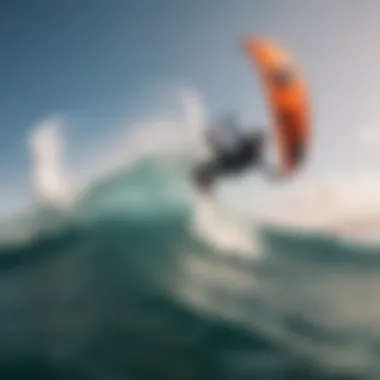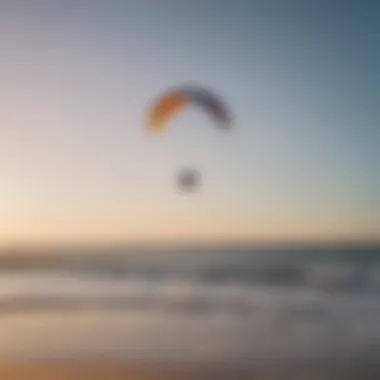Mastering the Backroll: A Kitesurfing Guide


Intro
Backrolling in kitesurfing is more than just a flashy move; it’s a statement about skill, style, and control. While it might look effortless when performed by seasoned riders, the intricacies of this maneuver reveal a level of finesse that separates the newcomers from the pros. As the kite soars overhead and the rider initiates the roll, the delicate balance of power, precision, and timing plays out in a stunning display.
Understanding backrolling begins with recognizing its significance in the broader kitesurfing culture. This technique is often seen as a rite of passage; nailing that first backroll is a moment of triumph that many riders cherish. It’s not just about catching air; it's about embracing the wind and water in a way that feels both liberating and exhilarating.
In this guide, we will take a deep dive into the various components of backrolling, helping you dissect what makes it tick and pointing out common pitfalls along the way. Whether you're a novice kitesurfer eager to master your first roll or an experienced rider looking to refine your style, this resource serves you well, covering everything from equipment choices to safety considerations.
Let’s embark on this journey where each twist and turn of the roll brings us closer to a more profound understanding of the artistry behind this technical maneuver.
Intro to Backrolling
Backrolling is more than just a flashy maneuver in kitesurfing; it's a rite of passage for many riders. As you strap into your board and glide onto the water, the thrill of mastering the backroll can elevate both your skill set and your confidence in the sport. This section is crucial, as it lays the groundwork for understanding not only what backrolling is but also why it's significant in the broader kitesurfing community.
Defining the Backroll
A backroll is essentially a backward rotation in the air, initiated during a jump. The rider leverages the kite's pull and their body dynamics to achieve this rotation. It's not simply about flipping your body; instead, it involves meticulous timing and body positioning. As you launch off the water, think of loading up like a spring. You’re not just vertical; you’re bending your knees and edging against the kite's pull to harness its potential energy.
The key elements to focus on when defining a backroll include:
- Jump Initiation: The launch is often referred to as the "pop"—a critical moment where you gain altitude.
- Body Positioning: Curving your body into a compact position helps maintain spin speed.
- Kite Control: Keeping the kite on a proper line is vital. If it’s too high or too low, it can throw off your balance.
In short, defining a backroll is about understanding the combination of equipment, technique, and rider skill.
The Significance of Backrolling in Kitesurfing
Backrolling holds a special place in the hearts of many kitesurfers. It’s not just about nailing the move; it's about the experience and the statement it makes. Riders who master the backroll gain respect within their circles and become familiar faces in the kitesurfing culture.
There are several reasons why backrolling is significant:
- Skill Development: It challenges riders to refine their timing and aerial awareness.
- Performance Marker: Many competitions judge riders on their ability to execute complex movements like the backroll.
- Community Influence: Mastering this maneuver can inspire both new and seasoned riders, creating an environment of encouragement and shared learning.
"A backroll is like writing your name in the sky. It shows you’ve arrived, and you mean business."
In the kitesurfing culture, backrolling represents more than just personal achievement; it’s about pushing boundaries and embracing a progressive mindset. So, if you’ve ever thought about incorporating backrolling into your routine, you're not just learning a trick; you’re becoming part of a legacy that continues to shape the sport.
Understanding the Technique
Understanding the technique behind backrolling is akin to laying the groundwork for a well-built house. It's essential, as mastery of the maneuver hinges on several interrelated elements that contribute to a successful execution. It’s not just about a whimsical jump into the air; it’s an intricate dance of body mechanics, timing, and kite control that ultimately showcases the rider's skill level.
When you break down the backroll, you're diving into aspects like timing your jump, managing the kite’s position, and controlling your body’s rotation. Each of these components plays a pivotal role, affecting how smooth the move looks and how effectively it is executed. A deeper understanding leads to better muscle memory and more graceful maneuvers. Plus, knowing the technique helps riders evaluate their performance critically, noticing nuances that can be refined.
"Technique is everything; master it, and the tricks will come naturally."
Breaking Down the Maneuver
To nail the backroll, let’s dissect the maneuver into its fundamental parts. Initiation is where it all begins. A powerful edge is key - it’s like revving the engine before the race. The way to initiate the jump is by digging that heel edge firmly into the water, using the kite's upward pull effectively to launch you. Imagine a spring compressing and then releasing; that’s the energy you want to harness.
Once you've initiated the jump, you need to understand how to shift your weight mid-air. Tilt your head back to spot your landing. This not only helps you control the rotation but also sets up the body for a smooth landing by keeping your center of gravity aligned. You want to feel the fluidity of the motion, flowing like a well-crafted wave.
Body Positioning and Mechanics
In kitesurfing, the difference between landing a trick and taking a tumble often comes down to body position. During a backroll, positioning your body correctly is essential for rotation and landing cleanly. Start by keeping your knees bent and your body compact. This positioning conserves energy and promotes stability.
Your arms should be slighty bent, kind of like a marionette, guiding your movement rather than flailing about. Hold the kite’s bar close to your body, maintaining tension to ensure the kite maintains lift throughout. Even when airborne, don’t forget about your kite; if it’s not angled properly, the chances of executing the move successfully drops significantly.
Remember, maintaining balance is the name of the game. By positioning your body close to the center of mass, you make it easier to rotate and stabilize yourself upon landing. It’s that fine balance – the art and science of backrolling in kitesurfing.
Equipment Considerations
When delving into the world of backrolling, the significance of equipment cannot be overstated. The right setup can make or break your attempts at mastering this thrilling maneuver. Choosing the appropriate kite and board not only enhances performance but also ensures safety, allowing you to focus on perfecting the technique rather than battling equipment issues.


Kite Selection for Backrolling
Selecting the right kite for backrolling is akin to picking the appropriate paintbrush for a masterpiece. Not all kites are created equal when it comes to executing aerial tricks. You want a kite that offers a balance of power and stability. A kite with good lift capabilities is crucial because it propels you high enough into the air to give you time to rotate, but it also needs to have a responsive handling to facilitate maneuvering in the air.
- Size Matters: If the winds are light, a larger kite may do the trick, allowing you to gather sufficient pull. Conversely, in strong winds, a smaller kite provides better control.
- Types of Kites: C-kites are favored for their direct power and response, while bow kites offer a soft, gradual lift that some find beneficial for backroll transitions.
Testing out kites in various conditions can help you understand how different designs affect your ability to backroll. Take the time to experiment, and don’t hesitate to ask seasoned riders for their insights on their kite choices.
Choosing the Right Board
The right board can significantly impact your backrolling experience. A board that's too heavy might hinder your ability to rotate, while one that's too light can make control during the landing problematic. Therefore, finding a middle ground is key.
- Board Size and Shape: Look for a kiteboard that’s suitable for the kind of water you're riding in. For flat water, a slightly wider board might offer better stability in the air. On the other hand, if you are tackling waves, a more directional shape can help in maintaining edge control during the water re-entry.
- Flexibility: The flex of the board plays a role in how it reacts to your movements. A stiffer board provides immediate response for quick rotations, while a more flexible board can add that little extra pop during jumps.
Another point to consider is the foot strap settings. Making sure they’re adjustable and comfortable helps improve your overall control during the maneuver. Don’t be shy about trying before you buy, as finding your perfect match in board and kite can take some trial and error.
"Investing in the right gear isn’t just about performance; it’s about building confidence in your abilities. Without it, you’re just spinning your wheels—literally."
Crafting an ideal setup for backrolling might seem daunting, but with deliberate choices, you will enhance not only your skill but also your enjoyment on the water. Each element plays a vital role, contributing to the overall success of your backrolling journey.
Preparation for Backrolling
Preparation is the bedrock upon which successful backrolling stands. This isn't simply about willingness; it encompasses various considerations that make the difference between a polished performance and a clumsy tumble into the water. When you're heading into that exhilarating spin, it's vital to set a solid foundation.
Safety Precautions
Safety should always come first, particularly in an extreme sport like kitesurfing. A few careful steps can ensure that you minimize risks associated with backrolling.
- Wear a Harness: Choosing the right harness can significantly affect your comfort and control during the maneuver.
- Inspect Your Gear: Before hitting the waves, a quick inspection of your kite, lines, and board is essential. Look for any signs of wear and tear or damage.
- Check the Weather: Wind conditions dramatically influence your ability to perform. Too much wind might make it rough, while too little can lead to unplanned crashes.
- Buddy System: It is always a smart move to kite with a partner. Should anything go wrong, having an experienced friend nearby can be reassuring and potentially lifesaving.
"It’s better to be safe than sorry. In an unpredictable sport, caution is your best ally on the water."
Warm-Up Exercises
Warming up is crucial not just for flexibility but also for preventing injuries. Engaging in proper warm-up exercises prepares your body for the physical demands of kitesurfing.
- Dynamic Stretching: Movements like arm circles, leg swings, or torso rotations can increase blood flow and warm up your joints.
- Balance Drills: Standing on one leg or doing yoga poses can help refine your balance, which is key during a backroll.
- Core Workouts: Sit-ups or simple planks can engage your core strength, necessary for maintaining stability throughout the spin.
- Leg Strengthening: Squats or lunges can enhance the strength in your legs, equipping them for powerful jumps.
Taking these steps may seem mundane but they ensure your body is primed for action. Preparing adequately can turn a risky maneuver into a joyful expression of skill.
In summary, safety and thorough warm-up routines are essential elements in the preparation phase of backrolling. These not only bolster your performance but also contribute to a more enjoyable kitesurfing experience.
Executing the Backroll
Executing the backroll is a pivotal moment in a kitesurfer's journey. This maneuver not only amplifies the overall riding experience but also enhances one's ability in the sport. It represents a blend of skill, courage, and technique that, when mastered, can elevate a rider’s performance significantly.
Usualy, backrolling is not just about making a stylish flip; it’s about timing, precision, and how well one understands the dynamics of kitesurfing. When performed correctly, backrolls bring a new flavor to your routine, making every ride not just an adventure but a showcase of skill. By honing this technique, a rider can navigate through various conditions and express their individuality on the water.
Step-by-Step Guide
Initiating the Jump
The initiation of the jump is the first key step in backrolling. This is about the right timing as one approaches the crest of a wave or a flat patch of water. To successfully initiate this jump, you want to harness the power of the kite while also engaging your lower body. As you edge downwind, you need to pull on the back hand, which will help generate lift and create upward momentum.
The key characteristic of this aspect is all in the edge. If you catch a good edge, you can launch higher, which gives you more time to rotate. This has proven to be a popular method for many riders because it allows them more control over the jump. Another unique feature of the initiation is the necessity for a coherent rhythm between kite tilt and body mechanics. If mistimed, it could lead to under-rotating or not getting enough altitude, leading to a less successful maneuver.
Creating Rotation
After you’ve achieved lift, the next step is to create rotation. This phase is crucial – it’s where the magic happens. To rotate properly, you should look over your shoulder, keeping your head aligned with your body to maintain a tight axis during the flip.
The critical characteristic of creating rotation is your body positioning. Keeping your knees bent and your body compact helps in smoothly executing that backward spin. This approach is welcomed by riders. The unique feature here is the connection between the kite’s power and your upper body movement. If the kite pulls too hard or not enough it can throw the whole rotation off-balance.


Landing Techniques
After the rotation, it's time to consider landing techniques. The way one lands is just as important, if not more so, than how the jump is initiated or the rotation is performed. Riding out of the maneuver should feel effortless to the observer. To land successfully, you need to maintain control and prepare for the impact.
The main aspect of landing techniques is focusing on your stance. By bending your knees upon contact with the water, you absorb the impact and maintain your speed. This characteristic of landing keeps it seamless, ensuring a flow in your riding. It’s undoubtedly a beneficial approach for maintaining momentum after a backroll. However, overcommitting to the landing position might lead to a rough landing or losing control, so ensuring some flexibility in your stance is essential.
Tips for a Successful Execution
- Visualize the Move: Before you attempt a backroll, visualizing the move can help in understanding it better.
- Practice Consistently: Quality practice on flat water helps in mastering the technique.
- Use the Right Kite: Ensure that your kite is set up correctly for the conditions to make control easier.
- Find the Right Spot: Look for a place with stable winds and fewer distractions.
Remember, mastering the backroll takes time. Don’t get discouraged by a few falls; every attempt brings valuable experience.
Common Mistakes and Troubleshooting
Understanding the common pitfalls in backrolling can significantly enhance a kitesurfer's performance. Mistakes made during this dynamic maneuver not only hinder progress but also pose safety risks and can lead to frustration. By recognizing errors, riders can make adjustments that enable smoother executions and more impressive style. This part of the article addresses prevalent mistakes and how to troubleshoot them, ensuring that both novices and seasoned kitesurfers can refine their technique and avoid setbacks.
Identifying Common Errors
Many intricate elements factor into a successful backroll. Recognizing errors is the first step towards improvement. Here are some frequent mistakes riders encounter:
- Inadequate Speed: Often, riders don’t generate enough speed before initiating the jump, resulting in flat, lackluster rotations. Without speed, the kite may lose lift, throwing off the maneuver altogether.
- Poor Body Positioning: A common issue is improper body alignment. Riders sometimes lean too far back or forward instead of maintaining a neutral position. This misalignment disrupts balance, making it hard to control the descent.
- Over-rotation: In the attempt to achieve dramatic spins, some kitesurfers over-rotate, leading to difficult landings. Too much rotation can cause the rider to misjudge the landing and potentially crash into the water.
- Incorrect Timing: Not syncing the jump with the kite's power can be a critical mistake. A sudden pull or slack in the lines at the wrong moment can ruin the jump, leading to a fall.
- Neglecting Landing Techniques: Many riders do not prepare adequately for landing. This oversight can result in awkward impacts on the water, increasing the risk of injury.
"Anticipation and timing are everything; when they line up, magic happens in the air."
Effective Solutions
Mistakes are part of the learning curve—but knowing how to troubleshoot is essential. Here are actionable solutions to the common errors:
- Increase Speed Gradually: Build momentum before initiating the jump. Practicing controlled speed in different wind conditions can help gauge what’s necessary for an effective launch.
- Master Body Positioning: Maintain a balanced stance during the rotation. Focus on keeping your head and shoulders aligned with the board to ensure stability throughout the backroll.
- Control the Rotation: Practice the backroll slowly to get a feel for the rotation. Gradually push yourself towards faster attempts as your confidence grows, but keep the rotations controlled.
- Timing Exercises: Work on timing by coordinating movements with the kite’s pull. Drills that focus on jumping and landing without the backroll can help improve general timing.
- Landing Practice: Focus on landing softly, knees bent, leaning slightly forward. Practice landing gently on flat water before attempting in wave conditions. This helps reduce impact and maintain balance upon return.
Addressing these aspects will lead to improved technique and greater enjoyment while kitesurfing. With practice and determination, each kitesurfer can overcome their challenges and add style to their backroll.
Advanced Backrolling Techniques
Backrolling, while a stunning display of skill and flair in kitesurfing, can be further refined and personalized through various advanced techniques. Understanding the intricacies of these methods not only enhances a rider’s repertoire but also elevates their overall performance. This section delves into variations of the backroll and explores how combining backrolls with other maneuvers can significantly impact a kitesurfer’s style and execution.
Variations of the Backroll
The traditional backroll serves as the foundation for many exhilarating aerial maneuvers. However, its versatility allows for several exciting variations that kitesurfers can experiment with. Each variation offers its unique flavor and challenges riders in different ways.
- Hooked-In Backroll: In this approach, the rider remains hooked into the harness, allowing for greater stability during the rotation. This variation is often favored by those looking to transition into more complex tricks.
- Unhooked Backroll: Releasing the hook adds an element of risk and requires greater control. This variation emphasizes the rider's commitment to the maneuver, enabling them to achieve a more stylish execution.
- Backroll to Grab: Adding a grab while executing a backroll not only elevates the trick but also showcases the rider’s skill level. Grabs can vary from a simple rail grab to more challenging variations like the kite grab.
- Backroll with a Spin: Ultimately, combining a backroll with a spin on landing can give the trick an impressive finish. The added rotation creates a more dynamic visual, making it particularly appealing in competitions.
Each variation fosters a deeper connection between the rider and the kite while challenging technical proficiency. Mastering these backroll variations can set one apart in the competitive scene and reflects the artistry inherent in kitesurfing.
Combining Backrolls with Other Moves
To truly elevate the game of backrolling, Kitesurfers can blend backrolls with other tricks. This fusion opens a world of creative possibilities that amplify both technical skills and visual appeal. Here are a few notable combinations:
- Backroll to Front Loop: Transitioning directly from a backroll into a front loop can leave spectators breathless. Timing is everything with this maneuver, as it requires precision to maintain momentum.
- Backroll with a Tweak: A tweak involves extending one leg while the other is pulled beneath for effect during the trick. This creates an advanced visual appeal and adds flair to the execution.
- Backroll to Kite Loop: Performing a kite loop mid-backroll is as spectacular as it sounds. This daring technique combines aggression and technique, warranting a solid understanding of kite control and body positioning.
- Backrolls into Spinning: Incorporating spins not only boosts the complexity but also adds additional height and flair to the overall maneuver.
"Combining tricks elevates backrolling, creating a dialogue between technique and creativity. It's a chance to express one’s unique style on the water."
As you explore these combinations, remember that practice and confidence are key. Each successful integration brings you closer to developing a personal kiting style that stands out in any context.
Ultimately, mastering advanced backrolling techniques will position you as a key player in the evolution of kitesurfing culture, making it an exciting journey worth undertaking.
Backrolling in Different Conditions
Understanding how to backroll in various environmental conditions is crucial for mastering this maneuver in kitesurfing. The wind, water, and overall weather can significantly impact your performance, making it wise to adapt your technique accordingly. Each condition presents its own set of challenges and opportunities. Riders who learn to adjust often find they can execute backrolls more effectively while also enhancing their overall riding experience.
Optimal Weather Conditions


When it comes to kitesurfing, the wind often takes center stage. Generally, backrolling is most effectively done when the wind is steady and within a moderate range—typically around 12 to 25 knots. Here's why these conditions matter:
- Consistency is Key: Unpredictable gusts can throw off your timing, making it more difficult to execute a smooth rotation. In steady wind, you can focus on your technique rather than constantly compensating for changing conditions.
- Visibility: Cloudy or stormy weather can obscure visibility. Clear skies not only improve your sightline but also your confidence, which is essential for attempting tricks like the backroll.
- Temperature and Comfort: It's easier to perform when you're comfortable. Colder temperatures can stiffen your muscles and reduce your range of motion. Wind chill can quickly dampen your enthusiasm, so aim for a pleasantly warm day.
In essence, choose your weather wisely. When conditions align, you will find that the backroll flows more naturally, allowing you to focus on refining your technique.
Adjustments for Waves vs. Flat Water
The water surface plays a pivotal role in how you approach backrolling. Navigating waves and flat water requires distinct strategies:
Flat Water
When kitesurfing on calm, flat water, you have the luxury of a predictable surface. This usually allows for a more controlled jump, making it easier to focus solely on your rotation. Here are a few adjustments for executing backrolls in flat water:
- Smooth Surface: Use the calmness to your advantage by ensuring you land softly. By maintaining a lower edge angle upon landing, you’ll reduce the risk of wiping out.
- Jump Technique: You can take a more powerful jump. Without the interference of waves, spend more time focusing on your rotation, which is less limited by surface irregularities.
- Takeoff Angle: Aim for a slightly upward launch for a clean, vertical ascent. This orientation can improve your rotation speed.
Waves
In contrast, riding on choppy water or amidst waves demands a different mindset. The movement you get from the water can be both a challenge and an asset:
- Timing the Waves: Approach the jump when you’re at the apex of a wave, as this will provide an extra lift. However, this requires precise timing to ensure the wave assists rather than disrupts your motion.
- Adapt Your Rotation: Waves can create a bit of turbulence, so rely more on your body position and weight distribution to control your rotation. Stay compact and keep your eyes on where you want to land.
- Land on the Face: Aim to land on the downward slope of the next wave, which can help absorb some of the impact, ultimately offering a softer landing.
Balancing your technique according to whether you're in waves or flat water will help you optimize your performance. Recognizing these differences helps kitesurfers adapt their approach and execute backrolls seamlessly, whatever nature throws their way.
The Role of Backrolling in Kitesurfing Culture
Backrolling isn't just a flashy maneuver; it's a significant part of kitesurfing culture that showcases both skill and artistry. For many riders, mastering backrolls is not merely about individual achievement but about carving a niche in a vibrant community. The way a kitesurfer performs backrolls can transform an average session into a mesmerizing display, which in turn also influences the overall perception of the sport.
Backrolling in Competitions
In competitive kitesurfing, backrolls are more than just a crowd-pleaser; they are critical for scoring points. Judges often look for the fluidity of execution and the style with which a rider completes the maneuver. Competitions like the GKA Kitesurf World Tour frequently see riders incorporating backrolling into their runs, heightening the drama and displaying their prowess. This maneuver can set the tone for the rest of a competitor's performance. Riders who can seamlessly integrate backrolls with spins, grabs, or transitions often gain a competitive edge.
But it's not just about doing a backroll; it's about adding a personal flair. Some kitesurfers choose to throw in variations, such as late grabs or stylized landings, taking their backrolls from simple spins to showcases of individual creativity. These elements can tap into the audience's excitement, making the overall experience more engaging.
Influence on Kitesurfing Communities
The influence of backrolling extends well beyond the competition scene. In local kitesurfing communities, this trick serves as both a benchmark and an inspiration for newcomers. It's a common sight to see beginner riders pushing themselves to learn backrolls, driven by the desire to emulate their more experienced counterparts. This creates a pathway for mentorship and skill sharing, contributing to the strong bonds often formed within kitesurfing circles.
Moreover, backrolling has even generated its own set of cultural markers. From videos shared on platforms like Reddit or Facebook to tutorials on YouTube, aspiring kitesurfers are constantly exposed to the latest techniques and tricks. Peeps often celebrate their achievements with quick social media clips that highlight not just the tricks, but also the beauty of the sport.
“Every backroll completed is more than just a maneuver; it’s a step into a larger world of connectivity within the surf community.”
This social aspect is significant. Riders share advice, tips, and footage with one another, creating a sense of belonging that is foundational to the sport. Community events, often featuring backrolling contests or workshops, further embody this ethos, fostering a spirit of cooperation rather than competition.
In summary, the role of backrolling extends far beyond individual achievement. It acts as a bridge linking competitors, mentors, and social influencers within the kitesurfing culture. This synergy not only elevates the sport’s profile but also nurtures an ever-evolving community rooted in shared experiences and collective growth.
The End
The discussion around backrolling is more than just an analysis of a maneuver; it reflects the values and evolving nature of kitesurfing itself. The art of backrolling contributes significantly to a rider’s expression on the water. Here, we explore two key aspects that underline the importance of backrolling in kitesurfing.
The Evolving Nature of Backrolling
Backrolling has undergone a transformative journey from its initial inception to the diverse array of styles we see today. Early kitesurfers largely focused on basic jumps and tricks, but over time, the introduction of innovative techniques and equipment has led to a more dynamic evolution of the backroll. Riders now incorporate complex spins or combinations, tailoring their technique based on personal style or environmental factors.
Moreover, the technological advancements in kite and board designs have played a pivotal role. Modern shapes and materials allow for higher jumps and smoother rotations, vastly improving the overall execution of backrolls. As kitesurfers continue to push their limits, it’s clear that the backroll will keep changing, reflecting fresh interpretations and individual flair. This evolution encourages experimentation and creativity, reinforcing the notion that kitesurfing is not just about competition but about self-expression.
Encouragement for Continued Learning
Kitesurfing, particularly the backroll maneuver, is a never-ending journey of skill development and refinement. Each session on the water offers the opportunity to learn something new, whether it's perfecting the technique or improving body mechanics. For both novice and experienced riders, approaching backrolling with an open mind and a willingness to adapt is crucial.
Engaging with the kitesurfing community through online forums or local meetups can provide valuable tips and insights. For instance, platforms like reddit.com are filled with firsthand experiences from riders sharing their challenges and triumphs, which helps foster a sense of camaraderie.
Ultimately, continual learning ensures that backrolling remains not merely a technique but a craft. By committing to practice and staying abreast of evolving methods, every rider can discover their unique backroll style, enhancing not just their skills, but their overall enjoyment of the sport.
"The beauty of kitesurfing lies not just in the tricks you learn but in the joy of mastering them over time."
Backrolling embodies the essence of kitesurfing culture, urging riders to connect with their passion, practice modern techniques, and continuously strive for improvement in a sport that thrives on innovation and creativity.







